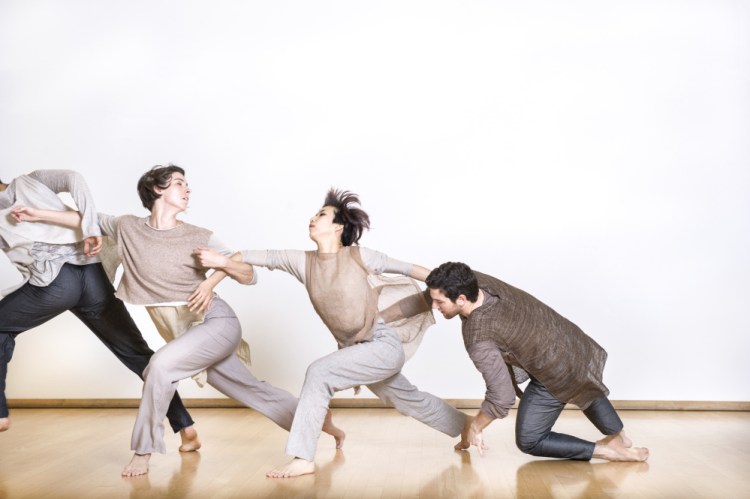Doug Varone’s dancers have a wonderful everyday quality: lithe, athletic and expressive, but without an appearance of rarefied artistic separation from normal humanity.
Varone’s choreography brings out this ineffable humanness, illustrated by both movement and discussion during a Show & Tell presentation Tuesday, part of the Bates Dance Festival.
Along with performance excerpts, the presentation included glimpses into the creative process Varone shares with his dancers. In one demonstration, he invited audience members to come on stage, huddle into a clump and then break away into poses of their choosing.
After joking to volunteers that they’d be remaining in place for a long time, to the dismay of those who had posed with extended limbs, he began directing his dancers in interactions with the stationary bodies.
Some instructions were delightfully silly, such as moving a forehead into the palm of a hand, or turning around to come closely face to face. Dancers executed Varone’s instructions using their own interpretations, such as choosing how to go under an extended arm. One direction said simply to “attach yourself to him somehow.”
After several dancers had learned movement sequences, volunteers left the stage and the dancers duplicated the movement as if the bodies were still there.
It was an entertaining demonstration of vicarious improvisation, but is this really how Varone creates? Apparently so, at least in part.
He described his fascination since childhood with the patterns of moving bodies, and his conscious interest in what dancers bring to his often-minimal directions. Varone’s choreography is never purely abstract, he explained, although dances may start out “about nothing” and then evolve into meaning. “The intricacy of bodies moving in space tells stories,” he said.
In the second choreographic demonstration, dancers Whitney Dufrene and Xan Burley followed instructions first from Varone and then from the audience.
Most directions involved just a change of orientation or a movement of one body part, but the dancers’ full-body interpretations brought out a sense of emotion and relationship. The final instruction, an audience member’s “melt down for, like, seven seconds,” became particularly evocative.
Dances “often start like this,” Varone asserted after the exercise, with open-ended “tasks for the dancers.”
During the Q&A, Dufrene conveyed how Varone’s approach gives dancers a feeling of family and individual voice. “We have permission to exist as we are,” she said.
Performance excerpts included two dances from a suite in development, one new piece and one that has been in the troupe’s repertory for a decade.
A duet from the suite (with the working title “States of Belief”) exemplified how choreography can seem simultaneously abstract and meaning-rich.
Alex Springer and Hollis Bartlett performed to a tense, sometimes dissonant score by Julia Wolfe. Choreography included unison, mirroring and reactions when one dancer’s touch seemed to push, or shock, the other into movement. Much of the movement was tight, even robotic, and some of the dancers’ clasps and lifts produced awkward shapes.
Meaning wasn’t underlined, except that the duet was about relationship. Perhaps the dancers represented lovers or friends ensnared in a battle between sympathy and anger. Perhaps they were warriors acknowledging essential brotherhood even in combat and mourning the results of their conflict.
Also from “States of Belief” was a solo by Hsiao-Jou Tang to solo piano. There was beautiful lightness and stillness in Tang’s performance, both in held poses and when a hold was released, sometimes with movement as subtle as the unwinding of her fingers.
Performance excerpts also included part of “Lux,” a fluid group piece choreographed in 2006 to a Philip Glass score, and of “ReComposed,” a 2015 work performed to Michael Gordon’s “Dystopia.” Varone explained that the latter was inspired by the pastels of Joan Mitchell, whose work deeply resonates with Varone, especially in their shared sense of “controlled chaos.”
“ReComposed” will be performed in full by Doug Varone and Dancers on Friday and Saturday evenings at Bates, along with “Possession” (1994) and Varone’s solo “The Fabulist” (2014).
Jennifer Brewer is a Portland-based freelance writer.
Send questions/comments to the editors.



Success. Please wait for the page to reload. If the page does not reload within 5 seconds, please refresh the page.
Enter your email and password to access comments.
Hi, to comment on stories you must . This profile is in addition to your subscription and website login.
Already have a commenting profile? .
Invalid username/password.
Please check your email to confirm and complete your registration.
Only subscribers are eligible to post comments. Please subscribe or login first for digital access. Here’s why.
Use the form below to reset your password. When you've submitted your account email, we will send an email with a reset code.